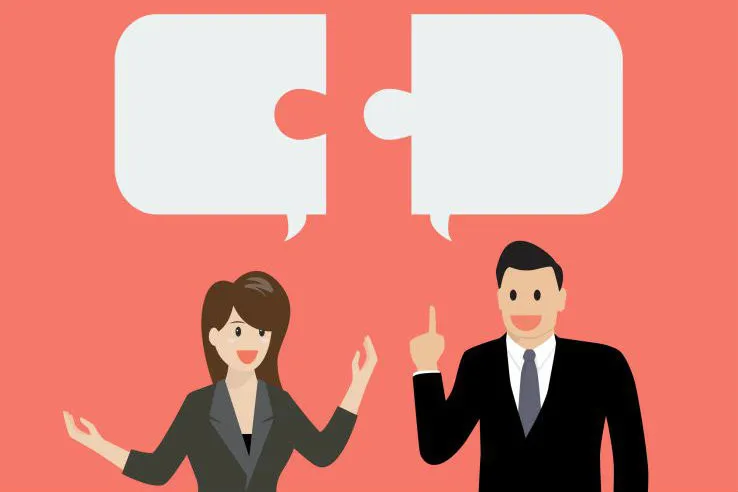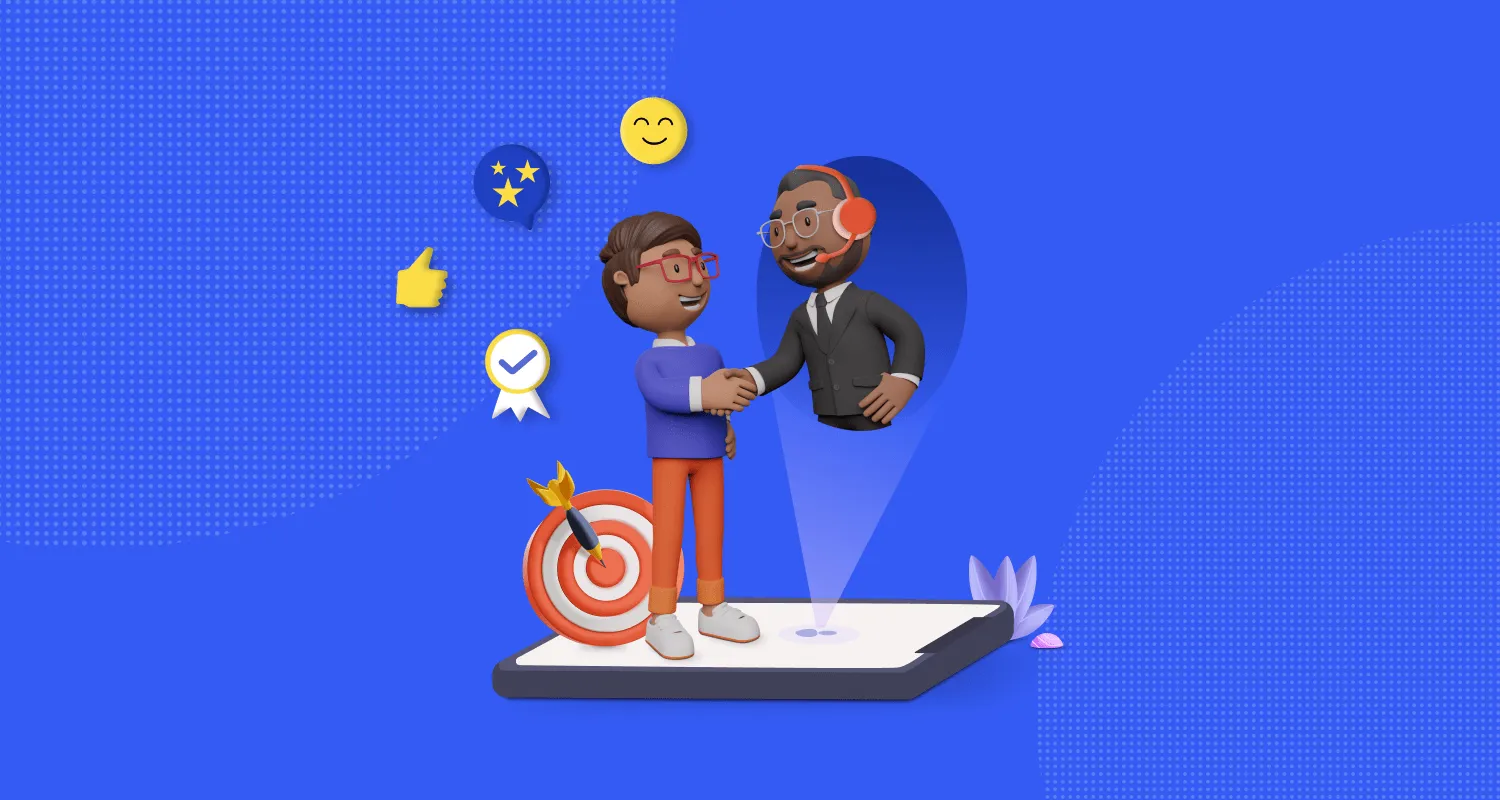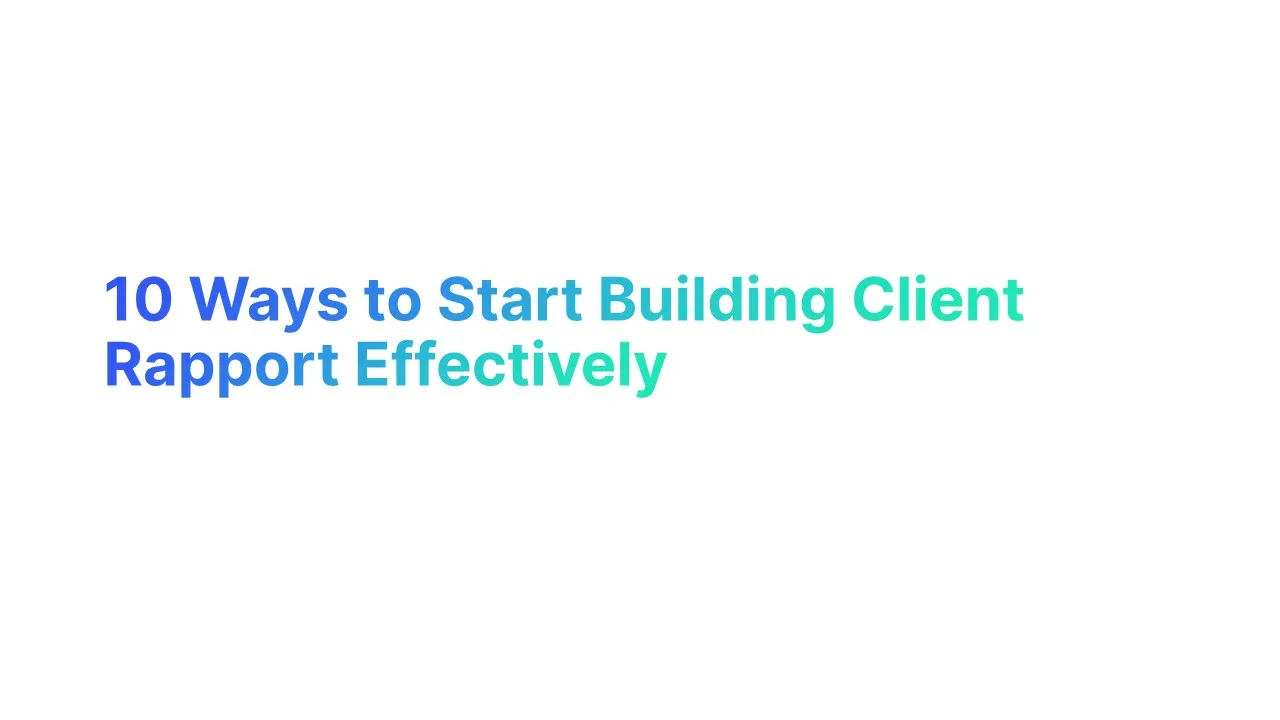Introduction to Building Client Rapport

What is Client or Customer Rapport
Client or customer rapport is the connection and relationship built through positive interactions that create trust and foster loyalty.
A Salesforce report revealed that 95% of customers are more likely to be loyal to a company they trust. Loyal customers are five times more likely to purchase again and four times more likely to refer a friend to the company.
Building client rapport is an essential component of successful business interactions. It refers to the establishment of a positive relationship between a business and its clients, marked by mutual trust, understanding, and effective communication.
Importance of Building Rapport
Building rapport with clients is fundamental to achieving long-term business success. It sets the foundation for a relationship based on trust, leading to numerous benefits that extend well beyond a single transaction.
1. Direct Business Impacts
Increased Customer Retention: Establishing a strong rapport significantly boosts client loyalty. Studies indicate that customers with strong brand attachments have a 306% higher lifetime value, demonstrating the economic benefit of nurturing relationships.
Enhanced Customer Satisfaction: Positive rapport leads directly to higher satisfaction rates. A report by the Temkin Group shows that companies leading in customer experience outperform laggards by nearly 80% on revenue growth.
2. Operational and Strategic Benefits
Smoother Communication: Good rapport facilitates open and effective communication, making it easier to understand and meet client expectations. This efficiency can reduce conflicts and misunderstandings, saving time and resources.
Greater Client Advocacy: Clients who feel a strong connection to a business are more likely to advocate on its behalf. Nielsen found that 92% of consumers believe suggestions from friends and family more than advertising, underscoring the value of word-of-mouth endorsements spurred by solid rapport.
3. Cultural and Employee Morale Enhancements
Positive Work Environment: When businesses focus on building rapport, it often reflects internally, leading to a more supportive and positive work culture. This can enhance employee satisfaction and retention, which are critical for maintaining service quality.
Feedback and Improvement: Good relationships encourage feedback, providing valuable insights into business operations and client needs. This continuous loop of feedback and improvement can drive innovation and keep a company competitive.
Example of Developing Rapport with Clients

Developing rapport with clients is an ongoing process that significantly impacts client satisfaction and business success. Here is a practical example
Initial Interaction: Building Trust and Understanding
During initial meetings, the sales team focused on actively listening to the clients’ needs. By maintaining eye contact and open body language, they conveyed genuine interest and attentiveness, laying a strong foundation for trust.
By using clients' names and referencing specific pain points they had mentioned, the team personalized their interactions and proposals, demonstrating their commitment to meeting each client's unique needs.
Ongoing Engagement: Strengthening the Relationship
The team established a schedule for regular communication, which included phone calls and email updates, to keep the clients informed about progress and developments. This consistent engagement helped in developing rapport by making the clients feel valued and involved.
During these interactions, the team used open-ended questions to encourage dialogue, such as, “What feedback do you have on our current strategy?” and “How can we better align with your goals?” These questions not only gathered useful insights but also deepened the relationship by involving the clients in the decision-making process.
Addressing Challenges: Solidifying Rapport Through Problem Solving
When challenges arose, the team focused on developing solutions promptly. They communicated openly about potential setbacks and collaborated with the client to adjust strategies as necessary.
Each successful resolution reinforced the client’s trust in the team’s capabilities and commitment, further solidifying the rapport. By demonstrating reliability and a willingness to adapt, the team ensured that the client felt supported and confident in their choice of vendor.
Long-Term Relationship Building: Beyond the Initial Sale
To sustain the rapport long-term, the team invited clients to participate in feedback sessions and offered exclusive insights into upcoming features and services.
Acknowledging both the team's and the client's achievements (e.g., successful project launches, reaching key performance indicators) helped to create shared interests and a deeper connection.
10 Ways to Build Rapport with Customers

Building rapport with customers is crucial for enhancing customer satisfaction and loyalty. Here are 10 practical ways to effectively build rapport:
1. Personalize Your Interactions
Personalization is key to creating memorable customer experiences. By tailoring interactions to the individual needs and preferences of your customers, you not only make them feel valued but also increase the likelihood of repeat business.
According to a study by Epsilon, 80% of consumers are more likely to make a purchase from a brand that provides personalized experiences.
How to Personalize:
- Use Customer Data Wisely: Leverage data from past purchases and interactions to tailor your communications. For instance, suggest products that align with their previous buying patterns.
- Celebrate Special Occasions: Send personalized messages or offers on birthdays or anniversaries to make your customers feel special.
2. Practice Active Listening
Active listening involves fully concentrating on the speaker, understanding their message, responding thoughtfully, and remembering the discussion. This skill is essential for building trust and rapport with customers.
Active listening validates the customer’s feelings and shows that their opinions are important, which can significantly enhance customer satisfaction and loyalty.
Effective Listening Techniques:
- Reflect and Clarify: To ensure you've understood, repeat back what the customer has said and ask clarifying questions.
- Respond Appropriately: Show that you've listened by providing solutions or support based on the customer’s input rather than generic responses.
3. Maintain Positive Body Language
Body language speaks volumes in face-to-face or video interactions. Positive body language can convey friendliness, openness, and willingness to help, which are crucial for fostering rapport.
Impact of Body Language: Studies suggest that nonverbal cues can make up 55% of the effectiveness of a spoken message. Positive body language makes interactions more engaging and personable.
Tips for Positive Body Language:
- Maintain Eye Contact: Eye contact shows you are focused and engaged, making the customer feel important.
- Smile Genuinely: A natural smile can put customers at ease, making them more comfortable in sharing their concerns or needs.
4. Use Empathetic Communication
Empathetic communication is about truly understanding your customers' feelings and perspectives, which helps in building deeper connections and trust.
Empathy leads to stronger customer relationships. A study by Businessolver found that 80% of customers are more likely to do business with a company if it offers personalized experiences, which empathy can facilitate.
How to Communicate Empathetically:
- Acknowledge Their Feelings: Use phrases like “I understand how that might be frustrating” to show that you recognize their emotions.
- Mirror Their Language: Reflecting the customer's language and sentiments helps validate their concerns and shows you are on the same page.
5. Follow Up Promptly
Prompt follow-up is crucial in showing customers that their time is valued and that their concerns or needs are taken seriously.
Importance of Prompt Follow-Up: According to a study by SuperOffice, 62% of companies do not respond to customer emails. Responding promptly can set you apart and significantly boost customer satisfaction.
Effective Follow-Up Strategies:
- Set Clear Expectations: Let customers know when they can expect a response or resolution and make sure to meet these timelines.
- Use Multiple Channels: Depending on the customer’s preference, follow up through emails, phone calls, or even social media.
6. Educate Your Customers
Educating customers about your products or services can empower them to make informed decisions, enhancing their trust and your credibility.
Benefits of Customer Education: A well-informed customer is more likely to be satisfied and less likely to have misconceptions or unrealistic expectations. Education can also reduce the workload on your customer support team by addressing common questions or issues upfront.
How to Educate Effectively:
- Provide Resources: Offer easy-to-understand manuals, FAQs, and how-to videos that help customers understand and use your products or services effectively.
- Host Workshops or Webinars: These can be great for engaging customers and providing them with valuable insights about the industry or detailed product usage demonstrations.
7. Ask Open-Ended Questions
Open-ended questions encourage a dialogue rather than a simple yes or no answer, allowing customers to express themselves more fully and providing you with deeper insights. This approach is crucial in establishing rapport and paying attention to the customer's needs.
These questions demonstrate your interest in what the customer has to say, leading to richer, more informative conversations. According to a report by Harvard Business Review, customer satisfaction doubles when they feel the company understands their needs.
Strategies for Implementation:
- Examples of Open-Ended Questions: “What goals are you hoping to achieve with our product?” or “Can you tell me more about your experience with our service?”
- Active Listening: Follow up their responses with further questions or summaries to show that you are truly listening and engaged, a tactic especially useful in managing calls as a call center agent.
8. Celebrate Customer Milestones
Recognizing important events in your customers’ journey with your brand can significantly enhance loyalty and emotional connection, essential for building strong customer relationships.
A study by Bain & Company shows that customers who feel valued are four times more likely to return, making celebration an effective retention strategy within your sales strategy.
How to Celebrate:
- Anniversary Rewards: Offer special promotions or discounts on the anniversary of a customer’s first purchase.
- Achievement Acknowledgments: Congratulate customers when they reach new levels of engagement or loyalty with your service, perhaps with a personalized email or a gift.
9. Offer Personalized Recommendations
Tailored recommendations are a powerful way to show customers that you understand their needs and care about their satisfaction, a key component of successful selling.
According to a survey by Accenture, 91% of consumers are more likely to shop with brands that provide offers and recommendations relevant to them.
Approaches to Personalization:
- Leverage Customer Data: Analyze purchase history and browsing behavior to suggest products that genuinely meet their needs.
- Customized Experiences: Create personalized shopping experiences or custom content that resonates with their preferences, ideal for preparing for the next sales call.
10. Create a Feedback Loop
A feedback loop involves seeking, listening to, and acting on feedback from customers. This not only helps improve your services but also shows customers that their opinions are valued, crucial in calming angry customers and fostering continuous improvement.
Feedback loops help businesses stay aligned with customer expectations and foster continuous improvement. According to Forbes, companies that implement regular feedback have a nearly 15% lower turnover rate.
How to Establish a Feedback Loop:
- Regular Surveys: Send out surveys after purchases or service interactions to gather insights.
- Community Engagement: Utilize social media or customer forums to encourage open dialogue and gather informal feedback.
Rapport-Building Questions You Need to Know

These questions are designed to open up dialogue, elicit meaningful responses, and demonstrate genuine interest in the person you're communicating with, all crucial for establishing rapport. Here are some key rapport-building questions that can help establish and deepen connections:
For Initial Meetings or Conversations
"Can you tell me about your role and what a typical day looks like for you?"
- This question helps you understand their daily responsibilities and challenges, showing your interest in their professional life during initial customer calls.
"What inspired you to enter this line of work?"
- Asking about their motivations and background fosters a personal connection and reveals more about their values and interests, which is foundational when you aim to establish rapport.
To Understand Their Needs and Challenges
"What are the biggest challenges you face in your role currently?"
- This allows you to identify opportunities where you may offer assistance or advice, showing your willingness to support them, a key aspect of building relationships.
"How do you measure success in your role or in your team's efforts?"
- Understanding their success metrics can help you tailor your interactions and recommendations to align with their goals, enhancing the quality of your customer calls.
To Build Deeper Personal Connections
"Outside of work, what kind of activities do you enjoy?"
- Learning about their hobbies and interests outside of the professional sphere can lead to more personalized interactions and common ground, crucial for building relationships.
"Are there any recent books, movies, or events that you have found interesting?"
- Sharing personal interests or recommendations can strengthen bonds and make future conversations more engaging, which is beneficial during follow-up customer calls.
To Encourage Reflection and Future Planning
"What’s one thing you would like to achieve in the coming year?"
- This shows that you are interested in their growth and future plans, which can be particularly motivating and encouraging in your efforts to establish rapport.
"Looking back, what’s one thing you would have done differently in your career?"
- Questions about past experiences can provide insights into their perspectives and decision-making processes, deepening the understanding crucial for effective relationship building.
To Solidify the Relationship
"How can I help you achieve your goals?"
- Directly offering your support can solidify your commitment to the relationship, demonstrating that you value their success as much as your own, a core aspect of establishing rapport.
"What’s the best way for us to keep in touch moving forward?"
- Ensuring there is a clear plan for future interactions shows that you value this relationship and are committed to maintaining communication, which is essential during ongoing customer calls.
Concluding Thoughts to Develop Rapport with Customers
In conclusion, building client rapport is not just a beneficial strategy—it's a critical element of modern business practice that directly impacts your company's success and sustainability. By personalizing your interactions, actively listening, and maintaining positive body language, you set the stage for strong, lasting customer relationships. Furthermore, by consistently practicing empathetic communication, following up promptly, and offering personalized recommendations, you demonstrate your commitment to customer satisfaction.
Emphasizing educational opportunities and engaging customers with open-ended questions not only enhances their experience but also solidifies their loyalty and advocacy for your brand. Celebrating milestones and creating a robust feedback loop are powerful tools that help sustain these relationships long-term. Each of these ten ways not only serves to build rapport but also integrates deeply into a holistic strategy for successful selling and relationship management. Engage with these practices to transform everyday customer interactions into enduring partnerships.









